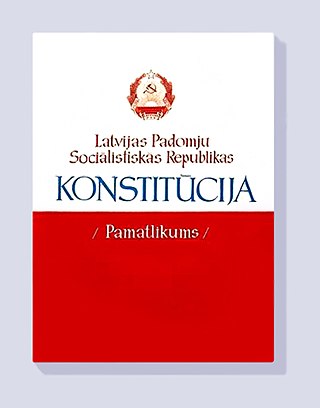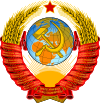
The Supreme Soviet of the Union of Soviet Socialist Republics was, from 1936 to 1991, the highest body of state authority of the Union of Soviet Socialist Republics (USSR), and based on the principle of unified power was the only branch of government in the Soviet state.

The original Constitution of East Germany was promulgated on 7 October 1949. It was heavily based on the Weimar Constitution and nominally established the GDR as a liberal democratic republic. In 1968, the East German government adopted a new, fully Communist constitution that was based on Marxism–Leninism, political unitarism, and collective leadership. There were further amendments to the 1968 constitution in 1974. With the political events of 1989, there were attempts to draft a new constitution for East Germany, but these efforts never materialized due to the dissolution of East Germany and the accession of its states into the neighboring Federal Republic.

The president of the Soviet Union, officially the president of the Union of Soviet Socialist Republics, abbreviated as president of the USSR, was the head of state of the Union of Soviet Socialist Republics from 15 March 1990 to 25 December 1991.

During its existence, the Soviet Union had three different constitutions enforced individually at different times between 31 January 1924 to 26 December 1991.
The 1936 Constitution of the Soviet Union, also known as the Stalin Constitution, was the constitution of the Soviet Union adopted on 5 December 1936.

The Constitution of the Russian Federation was adopted by national referendum on 12 December 1993. The last reform was in 2020, see 2020 amendments to the Constitution of Russia.

The Presidium of the Supreme Soviet was the standing body of the highest body of state authority in the Union of Soviet Socialist Republics (USSR). The presidium was elected by joint session of both houses of the Supreme Soviet to act on its behalf while the Supreme Soviet was not in session. By the 1936 and 1977 Soviet Constitution, the Presidium of the Supreme Soviet served as the collective head of state of the USSR. In all its activities, the Presidium was accountable to the Supreme Soviet of the USSR.

The political system of the Soviet Union took place in a federal single-party soviet socialist republic framework which was characterized by the superior role of the Communist Party of the Soviet Union (CPSU), the only party permitted by the Constitution.
The leading role of the party is a constitutional principle most common in communist states. It holds that the ruling party leads the state by virtue of being the vanguard of the proletariat.

The Constitution of the Republic of Belarus is the ultimate law of Belarus. The Constitution is composed of a preamble and nine sections divided into 146 articles.

In 1954, the Presidium of the Supreme Soviet transferred the Crimean Oblast to the Ukrainian SSR from the Russian SFSR. The territory had been recognized within the Soviet Union as having "close ties" to the Ukrainian SSR, and the transfer itself commemorated the Union of Russia and Ukraine Tercentenary. Amidst the dissolution of the Soviet Union in 1991, the Ukrainian SSR seceded from the Soviet Union and Ukraine continued to exercise sovereignty over the territory as the Autonomous Republic of Crimea. For just over two decades after 1991, Russia did not dispute the Ukrainian administration in Crimea, but retracted this stance on 18 March 2014, when Crimea was annexed by Russia after coming under Russian military occupation. The Soviet-era transfer of Crimea has remained a topic of contention between the two countries in light of the Russo-Ukrainian War, as the Russian government has stated that the Ukrainians must recognize Russia's sovereignty over the territory as part of any negotiated settlement to end the Russian invasion of Ukraine, which began in 2022.

The electoral system of the Soviet Union was varying over time, being based upon Chapter XIII of the provisional Fundamental Law of 1922, articles 9 and 10 of the 1924 Constitution and Chapter XI of the 1936 Constitution, with the electoral laws enacted in conformity with those. The Constitution and laws applied to elections in all Soviets, from the Supreme Soviet of the Soviet Union, the Union republics and autonomous republics, through to regions, districts and towns. Voting was claimed to be secret and direct with universal suffrage. However, in practice, between 1936 and 1989, voters could vote against candidates preselected by the Communist Party only by spoiling their ballots, or by voting against the only candidate, whereas votes for the party candidates could be cast simply by submitting a blank ballot. A person would be given a ballot by a clerk, and could immediately walk to the ballot box, and while there were booths in which one could strike the candidates they voted against off the ballot, this was easy to record and was not commonly done by voters.

The Declaration of State Sovereignty of the Russian SFSR was a political act of the Russian Soviet Federative Socialist Republic, then part of the Soviet Union, which marked the beginning of constitutional reform in Russia. The Declaration was adopted by the First Congress of People's Deputies of the Russian SFSR on 12 June 1990. It proclaimed the sovereignty of the Russian SFSR and the intention to establish a democratic constitutional state within a liberalized Soviet Union. The declaration also states the following:

The Government of the Union of Soviet Socialist Republics (USSR) was the executive and administrative organ of the highest body of state authority, the All-Union Supreme Soviet. It was formed on 30 December 1922 and abolished on 26 December 1991. The government was headed by a chairman, most commonly referred to as the premier of the Soviet Union, and several deputy chairmen throughout its existence. The Communist Party of the Soviet Union (CPSU), as "The leading and guiding force of Soviet society and the nucleus of its political system" per Article 6 of the state constitution, controlled the government by holding a two-thirds majority in the All-Union Supreme Soviet. The government underwent several name changes throughout its history, and was known as the Council of People's Commissars from 1922 to 1946, the Council of Ministers from 1946 to 1991, the Cabinet of Ministers from January to August 1991 and the Committee on the Operational Management of the National Economy from August to December 1991.

The Congress of People's Deputies of the Soviet Union was the highest body of state authority of the Soviet Union from 1989 to 1991.
The Ukrainian Soviet Socialist Republic, part of the Soviet Union, had four successive constitutions during its existence. The first (1919) was in Russian and the final three were in Ukrainian.

The Council of Ministers of the Union of Soviet Socialist Republics, was the de jure government of the Union of Soviet Socialist Republics (USSR), comprising the main executive and administrative agency of the USSR from 1946 until 1991.

The 1927 Constitution of the Azerbaijan Socialist Soviet Republic was adopted by the Central Executive Committee of the Azerbaijan SSR at the 5th All-Azerbaijani Congress of Soviets on March 26, 1927.

The 1978 Constitution of the Latvian SSR, officially the Constitution of the Latvian Soviet Socialist Republic was the constitution of the Latvian Soviet Socialist Republic adopted on April 18, 1978 at the eighth session of the 9th Convocation of the Supreme Soviet of the Latvian SSR.













